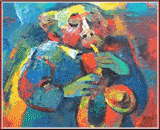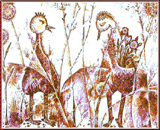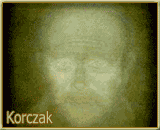
THE UNSTABLE BALANCE OF THE
EXISTENCE
Itella Mastbaum, who came to Israel in 1990, already had a reputation of
an interesting artist, book illustrator, stage designer, graphic artist,
and animator in the USSR. Her works were presented at various art
exhibitions both in the USSR and abroad, and could be found in many
private collections in Israel, the USA, Canada, Russia, South Africa,
Lands of Europe.
Itella does not favor any particular genre and she works in various media.
She is equally skillful in stage design and ceramics, miniature and
murals. Her style and her attitude to the world are remarkably individual.
Itella Mastbaum came to Israel as an established art-master. Despite all
obstacles posed by Soviet officialism (one could hardly overlook the
non-Soviet spirit of her art), she was very productive and fairly often
managed to avert the eyes of "watchers" - because she was a versatile
artist and never rejected any job offer (provided that it was an artistic
job), and because she was very diligent, never complained nor regretted.
Itella Mastbaum's inherent features are the emotional, theatrical-magical
vision of the world, sophisticated perception of the place, time, epoch.
That is why her stage sets and costumes are still alive and impress us
with their brightness, precise style and inexhaustible fantasy (no matter
how old are the performances themselves).
Once Itella said, that "the objects combined into a still life have
intrinsic magnetism and speak to each other in the language of colors".
But it seems to be true for all her works since she creates the world,
where all the inhabitants are active and animated, attract or repel, love
or hate each other, where everything is interwoven and interactive. This
is a magic, ancient world of a fairy tale. It is the creator's attitude to
the world, the attitude of the artist, which inspires, illuminates, and
even blesses the life, no matter how cruel and chaotic it may seem to us.
All these features are wholly applicable to Itella Mastbaum's series
titled Between Peace and War (Israel,
the end of 1999 - the beginning of 2000). These works could have been done
only in this country and only in our time. And yet, the true artist always
goes beyond the boundaries of his/her epoch and relates to the eternal
problems of human existence.
Despite the ultimate generalization and symbolism of images, which are
repeated from one work to another, in various combinations as musical
phrases, we distinguish the interpretations of Jewish history: it is
directly prompted by inscriptions interwoven into the exquisite pattern of
pictures, and to each of them there is a pertinent quotation from Jewish
Sources. The contemporary existence of Israel is directly associated with
its ancient history, and the events of today are both the continuation and
reiteration of the eternal Jewish destiny.
Jewish topics are not incidental for Itella Mastbaum. In the USSR she
illustrated many works by Jewish writers published in both Sovietish
Heimland magazine and Sovet-sky Pisatel Publishing House; she made
lithographs on the themes of Jewish folk songs and tales. Itella took part
in the organization of the first Jewish folk museum in Moscow as well as
in many events implemented by Moscow refusniks and Jewish national
activists in the mid-80s.
Her present approach to Jewish theme is different from all previous ones.
Now she creates the extremely symbolic, generalized and holistic world -
without any superficial distracting ornamentalism. Nothing but the
alarming, disturbing appeal to the audience, which is expressed with the
conviction of a Maestro.
The title of the series - Between Peace and War - is not a casual one. It
renders either a strained expectation of the nearing tragedy (Life on Edge
of Abyss, War Comes Near, Our House Is Here!, Flower in Captivity) or a
befallen disaster (Pogrom, Dance Around the Tree of Death). Other works
seem to tell of eternal topics, such as love, solitude, human
being-society confrontation (The First Birthday; Love, too...; Talk About
Life; Stranger), but the way of presentation which the whole series has in
common spreads the trace of uneasiness and anxiety.
Who are those strange, ponderous, and clumsy creatures? They look like
birds, but are wingless. They are doomed to stay forever on the earth, and
only stretch their beaks to the distant heaven, sad and long beaks, like
Jewish noses... Perhaps these defenseless, melancholy, peaceful birds,
which cannot stand up for themselves, personify the generalized image of
the Diaspora Jewry, depicted in such a bizarre, mythological form, so
typical of Itella Mastbaum? Here they are huddling together, turning their
beaks toward the huge stone with the word Shalom inscribed upon it, or
standing on an islet, along which the word Israel is written... And here
they are hiding in the crown of a huge tree, their final asylum, hanging
over the abyss...
These crowded huddling creatures experience constant discomfort and savage
animosity of the world they are confronted by. This world is dialectical,
unstable, and eternal in its instability like life itself. And the
artist's Jewish attitude to the world is also dialectical: both attracting
and repelling, it interacts with the new Israeli reality, where Itella
Mastbaum distinguishes familiar, alarming features of the Diaspora.
From the abundance of images, the artist selected only the most essential
ones, the leitmotif, which went from one work to another: a tree, a house,
stones, thorns, thus making the series complete and holistic. The series'
range of colors is dingy, brownish red, the color of the sun-scorched
earth and rusty-red sun. The lines form an elaborate counterpoint as a
result of the clashing of two opposing forces: the sharp, dangerously
thorny on the one hand, the oval, conciliatory on the other. An enemy,
which is opposed to these sad, wingless birds, has no specific, collective
image. It is rather a primordial force, which any moment threatens to open
an abyss, or to wither the land. The monster (War Comes Near) is faceless,
too. The evil is understood by Itella Mastbaum as a primordial hostile
element, in both the human beings and their world.
Being constructed according to the laws of theatrical performance, all
graphic folios are scenic: actors are playing their precisely outlined
character parts against the stage set. This technique creates the
atmosphere of emotional tension. As in any performance, there should be a
leading character, the center of attraction. In this series it is a tree.
A tree appears in almost all works as a symbol of the life, of
its primordial mysterious element: it saves and it betrays, and these
strange anthropomorphous creatures are born, and die, and perish in its
shade.
And is there anything stable, reliable in this life? What can withstand
the destructive forces of evil? Can it be a Word? (Not without a reason,
one of the works is called This Wonderful Word "Peace "). A word as a
dream, a word as a hope... Quotations from the Bible do not merely
interpret the pictures, linking them to Jewish history, but also reveal
the new dimension - outside of these works, of the depicted reality, and
is still related to them. Prayer for Peace and Rain shows us a sad,
tallith-clad creature, which, having drawn a circle, is praying with its
beak down. The crowns of trees are closed over him, and through the
branches, as in the far-off end of the tunnel, one can see the eye of the
torrid dazzling sun.
Yet and yet - perhaps all you need is to venture, to raise your head, to
cross the borderline of the drawn circle? To stand up straight, to have
faith in your strength, in the friendliness and support of the Heaven?
Only then the prayer will come true, and the refreshing rain will bathe
the Earth.
Alexander Lyubinsky,
Member of Union of Writers and Union of Journalists of Israel
Translation from Russian by Victor Gopman
|
|
SELECTED EXHIBITIONS
ONE MAN SHOWS
1977 Committee of Moscow Dramatics, USSR.
1978 "Sovietish Heimland" Yiddish Monthly Editorial Office,
Moscow, USSR.
1989 Sonya Rozin Gallery, Jerusalem, Israel.
1991 American Zionist Organization Gallery, Tel-Aviv, Israel.
1993 Community Center "Binyamin"; Psagot; Dolev, Israel.
1995 Koret Gallery, California, USA;
"Art Village" Gallery, Jerusalem, Israel.
1996 Milah Press, Jerusalem, Israel;
Forum Zionist Organization Library, Jerusalem.
2000 Community Center of Municipality, Jerusalem, Israel.
2001 Jerusalem Center MATAN, Israel.
GROUP SHOWS
1967-1989 Artists Union's Halls for Exhibition, Moscow, USSR.
1989 Artists House, Jerusalem, Israel.
1989-1991 Jewish Centers in the USA, Germany, France.
1990 "Temple" Gallery, Old City, Jerusalem, Israel.
1991 American Zionist Organization Gallery, Tel-Aviv, Israel;
WIZO Office, Tel-Aviv, Israel;
The Israel Museum Library, Jerusalem; Artists House, Jerusalem, Israel.
1992 Van Leer Institute; Congress Hall; Immigrants Club -
Jerusalem, Israel.
1992-1995 "Exodus" Gallery, Jerusalem, Israel.
1994 Artists House, Jerusalem, Israel;
Museum of Ashdod, Israel.
1995 "Art village" Gallery, Jerusalem, Israel.
1996 Nora Gallery, Jerusalem, Israel.
1997 International Cartoon Exhibition, Istanbul, Turkey.
1999 Autumn Exhibition Jerusalem Artists, Israel;
Zionist Forum Exhibition, Jerusalem, Israel;
Bible Museum, Tel-Aviv, Israel.
2000 Jerusalem Theatre, Israel;
Artists House, Jerusalem, Israel.
2001 Spring Exhibition of Jerusalem Artists
Member of Union of Artists of Israel and International Association of Art.
You may see the artworks of Itella in the Internet Gallery
www.antho.net/mastbaum
and in The Israel Goor Theater Archives and Museum in Jerusalem.
|





